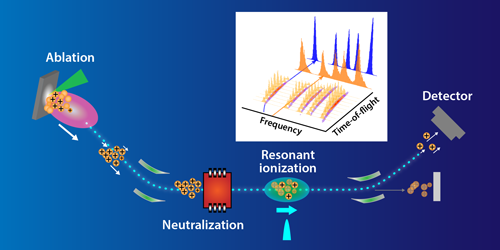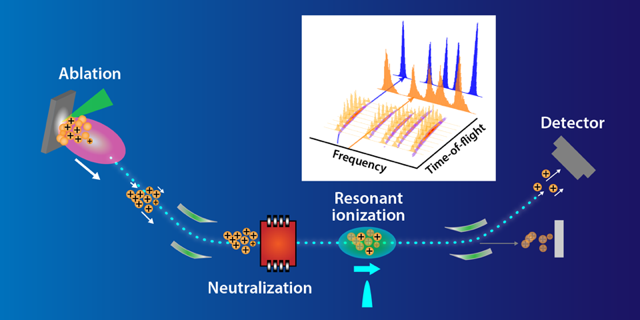Resonant Ionization Spectroscopy Technique Becomes Tabletop Friendly
Optical spectroscopy provides an important window into the atomic and subatomic world. It can be applied to determine nuclear, atomic, and molecular structures, to test fundamental physics theories, and to track radioactive isotopes for environmental, geological, and medical applications. Recently, researchers have developed spectroscopic methods with exquisite precision and sensitivity, which allow them to study rare or short-lived isotopes at the edge of nuclear stability. The technological complexity of these methods, however, has limited their application to large-scale radioactive-ion-beam (RIB) facilities. Now Ronald Garcia Ruiz, at CERN in Switzerland and at the University of Manchester in the UK, and colleagues have demonstrated a modified version of one such method that could potentially be implemented on a tabletop, opening up new experimental perspectives for other fields of science [1]. The new scheme uses a laser ablation process to produce ions that are then probed with a high-precision spectroscopy technique recently developed at CERN’s Isotope Separator On-Line Device (ISOLDE) facility. The researchers showed the potential of their method by measuring the tiny hyperfine energy-level splitting of two naturally occurring isotopes of indium, but the scheme could be suitable for studying a broad range of atoms, ions, and molecules.
Optical spectroscopy extracts fundamental properties of atoms, molecules, and ions by probing their energy-level structure with laser light [2]. When the interest is in nuclear physics, a wealth of information can be derived from observables such as the isotope dependence of energy-level shifts and the hyperfine structure—tiny shifts and splittings in the energy levels due to the interactions between the nucleus and the electron cloud. By measuring these observables with high precision, researchers can test nuclear models and look for possible signatures of exotic interactions associated with dark matter particles. In the past decades, researchers have developed several techniques optimized for the study of short-lived radioactive nuclei, which are important for testing nuclear-stability theories and are relevant to many astrophysical processes. Typically, such techniques have achieved either high resolution—the ability to resolve subtle spectral features—or high sensitivity—the ability to measure species with ultralow abundance.
High-resolution methods are exemplified by collinear laser fluorescence spectroscopy—a technique based on the collinear superposition of a fast beam of ions with a laser beam. When the laser light is tuned to an ionic transition, it excites the ions’ electrons, which then emit fluorescent photons as they lose their excitation. The ion spectra can be determined by measuring the fluorescence yield as a function of laser wavelength. The acceleration of the ion beam is key to achieving high resolution: the ions are accelerated to several tens of keV, but their initial energy spread is unaffected by the acceleration. As a result, the relative velocity spread of the ions is reduced by up to 3 orders of magnitude, with a corresponding reduction of the Doppler-induced broadening of the transitions to be measured. The resulting spectroscopic resolution is generally sufficient to resolve the ions’ hyperfine structure. High-sensitivity methods, on the other hand, rely on resonant ionization: they involve tuning the wavelength of high-intensity laser pulses to resonantly excite and ionize selected isotopes, which can then be separated from the main beam based on their mass and charge. These methods have achieved an impressive detection sensitivity of 0.1 ions per second but have worse spectral resolution than high-resolution methods [3]. As a result, their applicability is limited to heavy elements, which have larger, and thus more easily observable, hyperfine splittings and isotope shifts. A notable success of resonant-ionization methods has been the optical spectroscopy of nobelium (element 102), the heaviest element studied to date [4].
Recently, researchers at CERN’s ISOLDE facility have developed a new technique called collinear resonant ionization spectroscopy (CRIS) [5], which features both high resolution and high sensitivity. CRIS involves accelerating the ions produced by ISOLDE to compress Doppler broadening, as in collinear fluorescence spectroscopy. But the technique also includes a resonant ionization step in which laser pulses selectively ionize neutral atoms produced by passing the accelerated ions through a gas. CRIS’s performance was boosted by the installation of ion traps called cooler bunchers, which release ions in few-microsecond bunches that can be synchronized to the ionizing laser pulses. CRIS now provides researchers with regular access to the spectroscopic study of exotic nuclei at the limits of stability [6]. While these are fantastic developments, the question arises: Can one simplify the CRIS approach without compromising the benefits of resolution and sensitivity, providing a setup that doesn’t rely on radioactive-beam facilities like ISOLDE?
Garcia Ruiz and colleagues show that such a simplification is indeed possible. They achieve this feat by replacing the ion-injection scheme, based on complex cooler-buncher devices, with a source that produces ions through laser ablation from a solid surface (Fig. 1). Laser ablation can have a serious drawback for high-precision studies: it produces ions with a large energy spread, leading to large Doppler broadening. While some of this broadening is reduced by the ion acceleration, the authors implement an additional trick to overcome this difficulty: they correct the measured line shapes of the ions based on time-of-flight measurements that characterize the ion velocity. The authors use this information to process the acquired data and further suppress the spectral broadening.
The result is a setup that can resolve the hyperfine structure of two indium isotopes (indium-113 and indium-115) and clearly separate their spectra. The measurements yielded hyperfine parameters and isotope shifts for several atomic transitions, some of which had previously been measured, while others (such as the magnetic-dipole hyperfine structure constant) were measured for the first time. The agreement with literature values was excellent, providing an important benchmark of the technique. Using ab initio calculations, the authors demonstrate that the observables they measure are sensitive to important parameters used in many-body atomic models, suggesting that these experiments can be useful in refining and testing theoretical approaches.
The impact of this work, however, doesn’t reside in the specific results on indium but on the experimental perspectives that the technique might open. While demonstrated at an ion beam facility, the new laser-ablation-based scheme could be implemented with ion-acceleration and laser technology that could fit on a tabletop. Such a setup could enable several important research directions. The first is the study of light and highly reactive elements like carbon. Laser ablation would remove the need for complex and expensive trapping schemes for these elements, which require a cooling step employing dangerous H2 gas. A second field of application could be the tracing of isotopes in environmental samples. Laser ablation could produce bunches containing many more ions than those available from ion-trapping sources, allowing the tracing of low-abundance isotopes like carbon-14. Finally, the method could be applied to perform high-precision spectroscopic studies of molecules like fluoride, which could reach unprecedented sensitivity in the detection of signatures of beyond-standard-model physics [7]. While this list is by no means exhaustive, it gives sufficient reason to hope that tabletop spectroscopy techniques based on the authors’ scheme could soon address important fundamental and applied questions in physics and chemistry.
This research is published in Physical Review X.
References
- R. F. Garcia Ruiz et al., “High-precision multiphoton ionization of accelerated laser-ablated species,” Phys. Rev. X 8, 041005 (2018).
- P. Campbell, I. D. Moore, and M. R. Pearson, “Laser spectroscopy for nuclear structure physics,” Prog. Part. Nucl. Phys. 86, 127 (2016).
- The spectral resolution is limited by broadening effects due to either the high temperature of the ions (for ions produced in a hot cavity) or to collisions between the ions (for ions produced in a gas cell).
- M. Laatiaoui et al., “Atom-at-a-time laser resonance ionization spectroscopy of nobelium,” Nature 538, 495 (2016).
- K. T. Flanagan et al., “Collinear resonance ionization spectroscopy of neutron-deficient francium isotopes,” Phys. Rev. Lett. 111, 212501 (2013).
- R. P. de Groote et al., “Dipole and quadrupole moments of 7378Cu as a test of the robustness of the Z=28 shell closure near 78Ni,” Phys. Rev. C 96, 041302 (2017).
- M. S. Safronova, D. Budker, D. DeMille, D. F. Jackson Kimball, A. Derevianko, and C. W. Clark, “Search for new physics with atoms and molecules,” Rev. Mod. Phys. 90, 025008 (2018).





